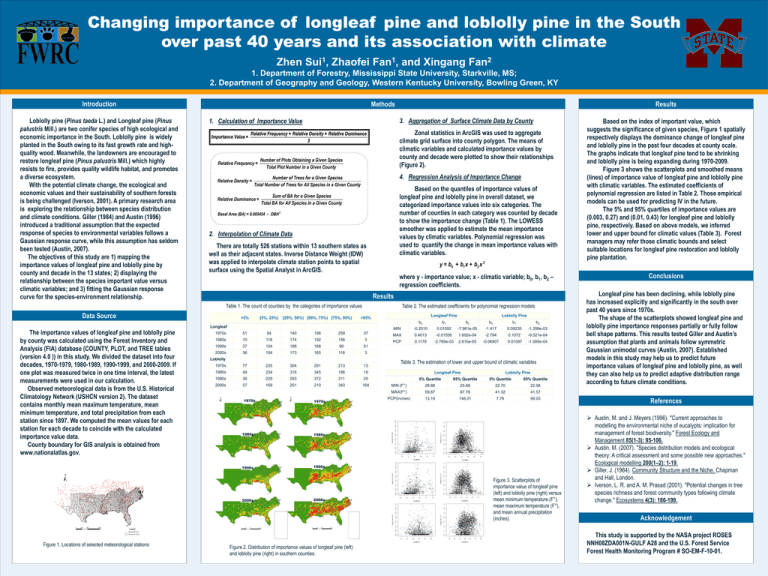Changing importance of longleaf pine and loblolly pine... over past 40 years and its association with climate
advertisement

Changing importance of longleaf pine and loblolly pine in the South over past 40 years and its association with climate Zhen Sui1, Zhaofei Fan1, and Xingang Fan2 1. Department of Forestry, Mississippi State University, Starkville, MS; 2. Department of Geography and Geology, Western Kentucky University, Bowling Green, KY Introduction Loblolly pine (Pinus taeda L.) and Longleaf pine (Pinus palustris Mill.) are two conifer species of high ecological and economic importance in the South. Loblolly pine is widely planted in the South owing to its fast growth rate and highquality wood. Meanwhile, the landowners are encouraged to restore longleaf pine (Pinus palustris Mill.) which highly resists to fire, provides quality wildlife habitat, and promotes a diverse ecosystem. With the potential climate change, the ecological and economic values and their sustainability of southern forests is being challenged (Iverson, 2001). A primary research area is exploring the relationship between species distribution and climate conditions. Giller (1984) and Austin (1996) introduced a traditional assumption that the expected response of species to environmental variables follows a Gaussian response curve, while this assumption has seldom been tested (Austin, 2007). The objectives of this study are 1) mapping the importance values of longleaf pine and loblolly pine by county and decade in the 13 states; 2) displaying the relationship between the species important value versus climatic variables; and 3) fitting the Gaussian response curve for the species-environment relationship. Methods 3. Aggregation of Surface Climate Data by County 1. Calculation of Importance Value Importance Value = Zonal statistics in ArcGIS was used to aggregate climate grid surface into county polygon. The means of climatic variables and calculated importance values by county and decade were plotted to show their relationships (Figure 2). Relative Frequency + Relative Density + Relative Dominance 3 Relative Frequency = Number of Plots Obtaining a Given Species Total Plot Number in a Given County 4. Regression Analysis of Importance Change Number of Trees for a Given Species Relative Density = Total Number of Trees for All Species in a Given County Relative Dominance = Results Based on the quantiles of importance values of longleaf pine and loblolly pine in overall dataset, we categorized importance values into six categories. The number of counties in each category was counted by decade to show the importance change (Table 1). The LOWESS smoother was applied to estimate the mean importance values by climatic variables. Polynomial regression was used to quantify the change in mean importance values with climatic variables. Sum of BA for a Given Species Total BA for All Species In a Given County Basal Area (BA) = 0.005454 × DBH 2 2. Interpolation of Climate Data There are totally 526 stations within 13 southern states as well as their adjacent states. Inverse Distance Weight (IDW) was applied to interpolate climate station points to spatial surface using the Spatial Analyst in ArcGIS. y = b0 + b1 x + b2 x 2 where y - importance value; x - climatic variable; b0, b1, b2 – regression coefficients. Results Table 1. The count of counties by the categories of importance values Data Source The importance values of longleaf pine and loblolly pine by county was calculated using the Forest Inventory and Analysis (FIA) database (COUNTY, PLOT, and TREE tables (version 4.0 )) in this study. We divided the dataset into four decades, 1970-1979, 1980-1989, 1990-1999, and 2000-2009. If one plot was measured twice in one time interval, the latest measurements were used in our calculation. Observed meteorological data is from the U.S. Historical Climatology Network (USHCN version 2). The dataset contains monthly mean maximum temperature, mean minimum temperature, and total precipitation from each station since 1897. We computed the mean values for each station for each decade to coincide with the calculated importance value data. County boundary for GIS analysis is obtained from www.nationalatlas.gov. <5% [25%, 50%) [50%, 75%) [75%, 95%) Longleaf Pine >95% Longleaf Loblolly Pine b0 b1 b2 b0 b1 b2 MIN -0.2510 0.01092 -7.961e-05 -1.417 0.09235 -1.299e-03 1970s 51 94 140 198 258 37 MAX 0.4013 -0.01556 1.602e-04 -2.794 0.1072 -9.521e-04 1980s 10 118 174 192 156 3 PCP 0.1179 -2.769e-03 2.610e-05 -0.06907 0.01097 -1.008e-04 1990s 37 134 188 168 90 51 2000s 36 154 173 165 118 3 1970s 77 235 304 291 213 13 1980s 48 234 316 345 186 19 1990s 38 229 293 372 211 25 2000s 57 169 251 210 343 164 Loblolly 1970s 1970s 1980s 1980s 1990s 1990s 2000s Figure 1. Locations of selected meteorological stations [5%, 25%) Table 2. The estimated coefficients for polynomial regression models 2000s Figure 2. Distribution of importance values of longleaf pine (left) and loblolly pine (right) in southern counties. Table 3. The estimation of lower and upper bound of climatic variables Longleaf Pine Loblolly Pine 5% Quartile 95% Quartile 5% Quartile 95% Quartile MIN (F°) 29.68 25.68 22.70 22.96 MAX(F°) 59.87 87.79 41.32 41.57 PCP(Inches) 13.19 146.01 7.76 99.03 Figure 3. Scatterplots of importance value of longleaf pine (left) and loblolly pine (right) versus mean minimum temperature (F°), mean maximum temperature (F°), and mean annual precipitation (inches). Based on the index of important value, which suggests the significance of given species, Figure 1 spatially respectively displays the dominance change of longleaf pine and loblolly pine in the past four decades at county scale. The graphs indicate that longleaf pine tend to be shrinking and loblolly pine is being expanding during 1970-2009. Figure 3 shows the scatterplots and smoothed means (lines) of importance value of longleaf pine and loblolly pine with climatic variables. The estimated coefficients of polynomial regression are listed in Table 2. Those empirical models can be used for predicting IV in the future. The 5% and 95% quartiles of importance values are (0.003, 0.27) and (0.01, 0.43) for longleaf pine and loblolly pine, respectively. Based on above models, we inferred lower and upper bound for climatic values (Table 3). Forest managers may refer those climatic bounds and select suitable locations for longleaf pine restoration and loblolly pine plantation. Conclusions Longleaf pine has been declining, while loblolly pine has increased explicitly and significantly in the south over past 40 years since 1970s. The shape of the scatterplots showed longleaf pine and loblolly pine importance responses partially or fully follow bell shape patterns. This results tested Giller and Austin’s assumption that plants and animals follow symmetric Gaussian unimodal curves (Austin, 2007). Established models in this study may help us to predict future importance values of longleaf pine and loblolly pine, as well they can also help us to predict adaptive distribution range according to future climate conditions. References Austin, M. and J. Meyers (1996). "Current approaches to modelling the environmental niche of eucalypts: implication for management of forest biodiversity." Forest Ecology and Management 85(1-3): 95-106. Austin, M. (2007). "Species distribution models and ecological theory: A critical assessment and some possible new approaches." Ecological modelling 200(1–2): 1-19. Giller, J. (1984). Community Structure and the Niche. Chapman and Hall, London. Iverson, L. R. and A. M. Prasad (2001). "Potential changes in tree species richness and forest community types following climate change." Ecosystems 4(3): 186-199. Acknowledgement This study is supported by the NASA project ROSES NNH08ZDA001N-GULF A28 and the U.S. Forest Service Forest Health Monitoring Program # SO-EM-F-10-01.




